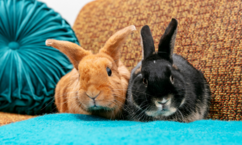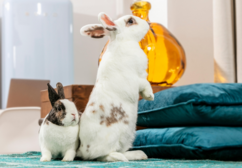Client Support - Housing
Adequate Space
Rabbits are very active animals; in the wild they run an average of 3 miles per day at speeds of up to 35 mph. They also like to jump, stretch, stand up, dig and forage. Many owners underestimate how much space their rabbit needs, and confinement can lead to high levels of stress, depression, behavioural problems and weight gain.
It is widely recommended that rabbits are able to do at least three hops when enclosed in their hutch - equating to an area of 6 ft x 2 ft minimum, and no less than 2 ft high so the rabbit is able to stand up.
On top of this, rabbits should be allowed out of their hutch into a larger area for at least three hours per day to exercise.
Rabbit-proofing
There are many dangers for both indoor and outdoor rabbits which some owners may not be aware of, especially if it is their first time owning a rabbit.
Rabbits are very curious animals and love to explore. It is often worth reminding owners that for indoor rabbits it is important that any wiring or cables are covered, and that any electrical, valuable or sharp items are out of reach.
For outdoor rabbits, most owners are conscious of predators but do not always realise the extent of this threat. Predators include feral cats, dogs and birds of prey. Even spotting a predator can be enough to induce a panic attack, which can lead to a heart attack or physical injury including a broken back. Every precaution should be taken to ensure safety in the outdoor rabbit's environment.
Useful tips for outdoor rabbits:
- Provide access to hiding places in the hutch with multiple entrances
- Padlock hutches
- Raise outdoor hutches above ground level
- Surround the hutch with a protective fence
- Bring rabbits indoors at night
A common misconception amongst owners is that that their pet rabbit will know which plants are dangerous, and avoid eating them. It is important to inform rabbit owners of the lethal plants for rabbits so these are out of reach of outdoor rabbits. See our nutrition page for further information.
Environmental Risks
The summer can be a dangerous time for rabbits as they cannot sweat and struggle to cool down in high temperatures. Rabbits lose heat via their ears, so wiping the ears with a cool rag can help keep them cool.
Signs of overheating include:
- Drooling
- Panting
- Rapid breathing
- Lethargy
It is important to warn owners about this potentially fatal danger and recommend owners take rabbits to the practice as soon as possible if they display any of these signs.
Both indoor and outdoor rabbits are at risk of exposure to infectious diseases. Owners may not be aware of this and need advice on how to reduce this risk, vaccination being the first port of call.
Enrichment
As rabbits are active and curious it is important that their environment is adequately stimulating to prevent boredom and depression. Owners should understand the importance of providing toys and an interesting environment for their rabbit. Simple measures such as moving runs around the garden and rotating their toys can help.
Rabbit are social animals, and the majority should live in pairs. It is important to stress the importance of companionship in rabbits to owners. Despite common belief, it is advised to prevent rabbits being kept with guinea pigs as rabbits can bully their smaller companions. Additionally, rabbits may carry Bordetella bronchiseptica as a commensal which can cause serious respiratory disease in guinea pigs.
Nobivac® Myxo-RHD PLUS contains live myxoma vectored RHD virus strain 009 and MK 1899. POM-V
Further information is available from the SPC, datasheet or package leaflet.
Advice should be sought from the medicine prescriber.
Prescription decisions are for the person issuing the prescription alone.
Use Medicines Responsibly.
MSD Animal Health UK Limited, Walton Manor, Walton, Milton Keynes, MK7 7AJ, UK
Registered in England & Wales no. 946942







